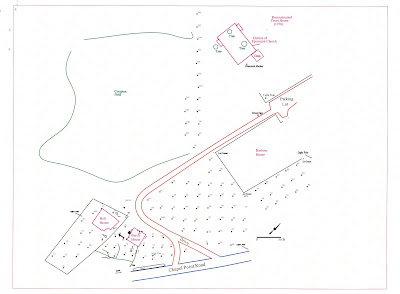Library research often feels like fieldwork. I have a general sense of what I am looking for but never know what I will find. This break in fieldwork has allowed me to return to my home institution,
Binghamton University, to partake in some much needed library time.
So far I have found an interesting mix of references on Port Tobacco. The oldest is Isaac Weld's
1807 book detailing his North American travels from 1795 to 1797. Weld provides a general description of the town:
"Port Tobacco contains about eighty houses; most of which are of wood, and very poor. There is a large English episcopalian church on the border of the town, built of stone, which formerly was an ornament to the place, but is now entirely out of repair; the windows are all broken, and the road is carried through the church-yard, over the graves, the paling that surrounded it having been torn down." (137-138)
A similar traveler's account is Robert Sutcliff's
1812 book covering his journey of 1804 to 1806.
"On the 21st of the 9th Month, 1804, I left Alexandria, crossed the Potowmack [sic], and went down to Port-Tobacco. In my way I passed through Piscattaway, where I dines, and where, amongst other things, broiled squirrels were served up at table. In travelling along this day, I observed that the population of this part of the country consisted chiefly of black people; and, in many parts of the road, I noticed it was mostly tracked with bare feet, some of which appeared to be immoderately large, arising, probably, from their almost constant practice of going barefoot." (47)
Since Port Tobacco was a backdrop for the events surrounding the
Lincoln assassination, there are also several authors that appear to have projected their anger onto the town as a whole.
George Alfred Townsend's
1865 book on
John Wilkes Booth provides the following description of Port Tobacco:
"If any place in the world is utterly given over to depravity, it is Port Tobacco. From this town, by a sinuous creek, there is flat-boat navigation to the Potomac, and across that river to Mattox Creek. Before the war, Port Tobacco was the seat of a tobacco aristocracy and a haunt of negro trades. It passed very naturally into a rebel post for blockade-runners and a rebel post-office general. Gambling, corner-fighting, and shooting matches were its lyceum education. Violence and ignorance had every suffrage in the town. Its people were smugglers, to all intets, and there was neither Bible nor geography to the whole region adjacent. Assassination was never very unpopular at Port Tobacco, and when its victim was a Northern President, it became quite heroic. A month before the murdr, a provost-marshal was slain in his bed-chamber. For such a town and district, the detective police were the only effective missionaries.The hotel here is called the Brawner House; it has a bar in the northernmost cellar, and its patrons, corousing in that imperfect light, look like denziens of some burglar's crib, talking robbery between their cups; its dining-room is dark and tumble-down, and the cusine bears traces of Kaffir origin; a barbeque is nothing to a dinner there. The court-house of Port Tobacco is the most superfluous house in the place, except the church. It stands in the center of the town, in a square, and the dwellings lie about it closely, as if to throttle justice. Five hundred people exist in Port Tobacco; life there reminds me, in connection with the slimy river and the adjacent swamps, of the great reptile period of the world, where iguanadons, and pterodactyls, and plesiosauri ate each other." (490)
La Fayette Curry Baker's
1867 book on the history of the
Secret Service provides some brief accounts that illustrate the political probhttp://www.blogger.com/img/gl.link.gif
lems Port Tobacco faced during the
Civil War.
Letter to Sec of State dated 1861
..."On my arrival at Port Tobacco, the headquarters of Colnel Graham's regiment, I found the inhabitants complaining bitterly at their alleged ill-treatment and depredations committed by the soldiers unger his command." (105) ..."The postmaster at this place is secrelty doing all in his power to further the interests of the ." (106)
I am sure there are many other historic descriptions of Port Tobacco still waiting to be discovered in the library. Off I go.
-April


















